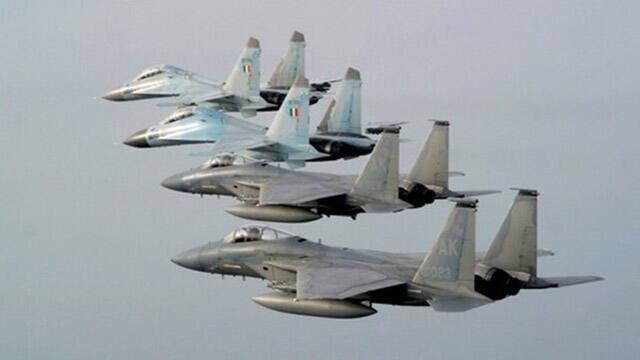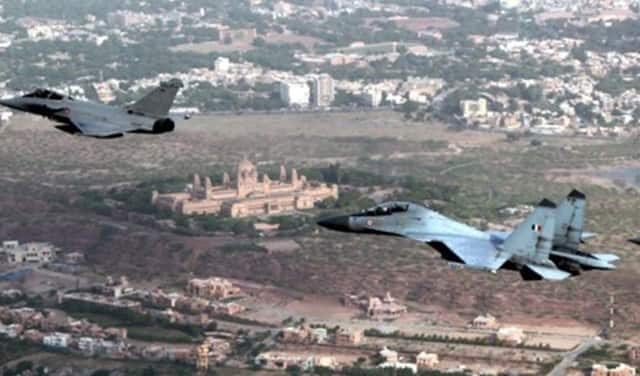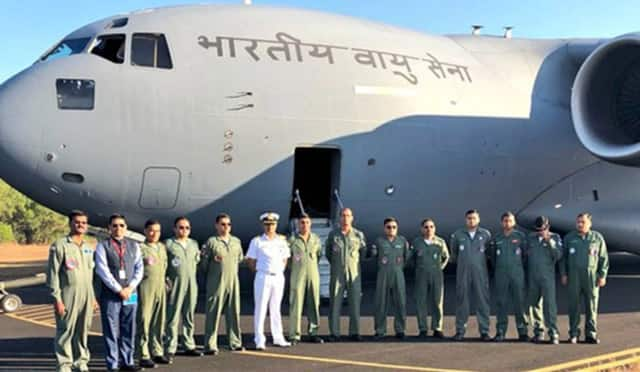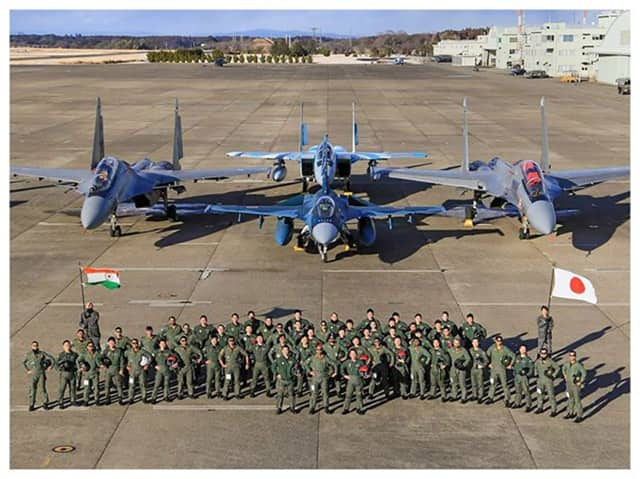IAF is planning its biggest air exercise to bring 12 nations to large-force engagements on Indian soil and shores. The “Tarang Shakti” will see fighter combat jets and large transport aircraft in action, supported by force multipliers. IAF’s global engagements are on the rise. Three Rafale fighter jets of the IAF will take part in the Bastille Day flypast over the Champs Elysees in Paris on 14 July. Prime Minister Narendra Modi will attend this year’s Bastille Day Parade as the guest of honour and a tri-services contingent will participate in the parade along with their French counterparts. IAF going big on exercises and interoperability IAF and USAF participated in the bilateral US Pacific Air Forces (PACAF) sponsored Field Training Exercise (FTX) Cope India series, conducted in India. Beginning at Gwalior in February 2004, the exercise was repeated in 2005, 2006, 2009 and 2018. Cope India-2023 was held in April this year across Kalaikunda, Panagarh and Agra bases. It included air engagements, demonstrations, as well as lectures on aviation subjects. It helped both sides in evaluating their intercept techniques and tactic. The IAF fielded Su-30s, Mirage 2000s, MiG 27s, Jaguars, and MiG 21s, and the USAF, F-18s, F-15s, C-130 J, among others. Exercise has also included airdropping training. [caption id=“attachment_12853852” align=“alignnone” width=“640”] Exercise Cope India. Image courtesy IAF[/caption] Exercise Garuda series is with the French Air and Space Force (FASF) since the first in 2003 at Air Force Station Jodhpur, India. Subsequently, they were held in 2005, 2006, 2010, 2014 and 2019. The other locations included Istres and Mont-de-Marson in France and Kalaikunda in India. French and Indian Rafale fighter aircraft, French A-330 Multi Role Tanker Transport (MRTT) aircraft, Indian Su-30 MKI, LCA Tejas, Jaguar fighter aircraft, the Light Combat Helicopter (LCH), and Mi-17 helicopters have participated. IAF also fielded combat-enabling assets like Flight Refuelling Aircraft (FRA) and AEW&C. The joint exercises were meant to augment the “operational capability and interoperability, while also sharing best practices”. In August 2022, a contingent of the FASF made a strategically important stop at the IAF’s Sulur base in Tamil Nadu on their way to Exercise Pitch Black 2022 in Australia. [caption id=“attachment_12854122” align=“alignnone” width=“640”]
Exercise Cope India. Image courtesy IAF[/caption] Exercise Garuda series is with the French Air and Space Force (FASF) since the first in 2003 at Air Force Station Jodhpur, India. Subsequently, they were held in 2005, 2006, 2010, 2014 and 2019. The other locations included Istres and Mont-de-Marson in France and Kalaikunda in India. French and Indian Rafale fighter aircraft, French A-330 Multi Role Tanker Transport (MRTT) aircraft, Indian Su-30 MKI, LCA Tejas, Jaguar fighter aircraft, the Light Combat Helicopter (LCH), and Mi-17 helicopters have participated. IAF also fielded combat-enabling assets like Flight Refuelling Aircraft (FRA) and AEW&C. The joint exercises were meant to augment the “operational capability and interoperability, while also sharing best practices”. In August 2022, a contingent of the FASF made a strategically important stop at the IAF’s Sulur base in Tamil Nadu on their way to Exercise Pitch Black 2022 in Australia. [caption id=“attachment_12854122” align=“alignnone” width=“640”] Exercise Garuda. Jodhpur. Image courtesy IAF[/caption] The 17-nation Multilateral Exercise ‘Pitch Black’ was held in Darwin, Australia in September 2022. Exercise Pitch Black is held alternative years since 2006, hosted by the Royal Australian Air Force (RAAF). India began participating in 2018. The aim is to practice Offensive Counter Air (OCA) and Defensive Counter Air (DCA) combat, in a simulated war environment. It traditionally consists of a ‘red team’ and a ‘blue team’ based at separate locations, with one attacking the other. As inferred from the name of the exercise, it takes place in low-light conditions. All Quad members and many from Indo-Pacific were part of the exercise, with over 100 aircraft and 2,500 military personnel participating. The IAF fielded four Su-30 MKI and two C-17 aircraft. The participating forces took part in various multi-aircraft combat drills by day & night, simulating complex aerial scenarios, involving large formations, and combined force engagements for enhancing interoperability and strengthening relationships in a dynamic warfare environment. It was also training for European countries’ ability to project power into the Indo-Pacific. It gave exposure to a very large cross-section of aircraft including the F-35s. [caption id=“attachment_12854302” align=“alignnone” width=“640”]
Exercise Garuda. Jodhpur. Image courtesy IAF[/caption] The 17-nation Multilateral Exercise ‘Pitch Black’ was held in Darwin, Australia in September 2022. Exercise Pitch Black is held alternative years since 2006, hosted by the Royal Australian Air Force (RAAF). India began participating in 2018. The aim is to practice Offensive Counter Air (OCA) and Defensive Counter Air (DCA) combat, in a simulated war environment. It traditionally consists of a ‘red team’ and a ‘blue team’ based at separate locations, with one attacking the other. As inferred from the name of the exercise, it takes place in low-light conditions. All Quad members and many from Indo-Pacific were part of the exercise, with over 100 aircraft and 2,500 military personnel participating. The IAF fielded four Su-30 MKI and two C-17 aircraft. The participating forces took part in various multi-aircraft combat drills by day & night, simulating complex aerial scenarios, involving large formations, and combined force engagements for enhancing interoperability and strengthening relationships in a dynamic warfare environment. It was also training for European countries’ ability to project power into the Indo-Pacific. It gave exposure to a very large cross-section of aircraft including the F-35s. [caption id=“attachment_12854302” align=“alignnone” width=“640”] Exercise Pitch Black. Image courtesy IAF[/caption] The Republic of Singapore Air Force (RSAF) and the IAF have been carrying out bilateral exercise SINDEX since 2004. They were held at airbases in India and Singapore. The RSAF’s F-16 C/D Fighting Falcons and F-5E Tiger fighter aircraft and the IAF’s Su-30 MKI, MiG 27, Mirage 2000 and Jaguar have been participating. IAF and Royal Air Force (RAF), conduct Exercise Indradhanush since 2006, held in both India and the UK. Indian Su-30 MKI and Mirage 2000 could engage with RAF’s Eurofighter Typhoons. Force multipliers from both sides take part. Lockheed Martin C-130J Hercules transport aircraft and RAF Regiment Paratroopers also practiced operations. The exercise included close combat and Beyond Visual Range (BVR) engagements. IAF has also been participating in the US Air Force (USAF) Red Flag exercise in Nellis Air Force Base, and at Eielson AFB in Alaska in the United States. Desert Eagle is a multilateral exercise organised by United Arab Emirates Air Force. IAF has also been participating in the exercise Eastern Bridge with Oman. Blue Flag is a military aviation exercise held by the Israeli Air Force. In July 2022, the IAF carried out a one-month-long engagement with the Egyptian Air Force (EAF) at the Egyptian Fighter Weapon School, located at Cairo West Air Force Base. This was a first-of-its-kind interaction for both the air forces as it was conducted between their respective Fighter Weapon Schools. The Japanese Air Self Defence Force (JASDF) and IAF participated in bilateral air exercise SHINYUU Maitri-18 in 2018 at the IAF airbase in Agra. In January 2023, the bilateral air exercise Veer Guardian 2023 was held between the IAF and Japan Air Self-Defence Force (JASDF) in Japan. IAF’s Su-30 MKI and JASDF’s F-2 and F-15 aircraft participated. IAF participate in Exercise Orion at the Mont-de-Marsan airbase in France and exercise INIOCHOS at Andravida base in Greece, hosted by the Hellenic Air Force, both held in April-May 2023. [caption id=“attachment_12854462” align=“alignnone” width=“640”]
Exercise Pitch Black. Image courtesy IAF[/caption] The Republic of Singapore Air Force (RSAF) and the IAF have been carrying out bilateral exercise SINDEX since 2004. They were held at airbases in India and Singapore. The RSAF’s F-16 C/D Fighting Falcons and F-5E Tiger fighter aircraft and the IAF’s Su-30 MKI, MiG 27, Mirage 2000 and Jaguar have been participating. IAF and Royal Air Force (RAF), conduct Exercise Indradhanush since 2006, held in both India and the UK. Indian Su-30 MKI and Mirage 2000 could engage with RAF’s Eurofighter Typhoons. Force multipliers from both sides take part. Lockheed Martin C-130J Hercules transport aircraft and RAF Regiment Paratroopers also practiced operations. The exercise included close combat and Beyond Visual Range (BVR) engagements. IAF has also been participating in the US Air Force (USAF) Red Flag exercise in Nellis Air Force Base, and at Eielson AFB in Alaska in the United States. Desert Eagle is a multilateral exercise organised by United Arab Emirates Air Force. IAF has also been participating in the exercise Eastern Bridge with Oman. Blue Flag is a military aviation exercise held by the Israeli Air Force. In July 2022, the IAF carried out a one-month-long engagement with the Egyptian Air Force (EAF) at the Egyptian Fighter Weapon School, located at Cairo West Air Force Base. This was a first-of-its-kind interaction for both the air forces as it was conducted between their respective Fighter Weapon Schools. The Japanese Air Self Defence Force (JASDF) and IAF participated in bilateral air exercise SHINYUU Maitri-18 in 2018 at the IAF airbase in Agra. In January 2023, the bilateral air exercise Veer Guardian 2023 was held between the IAF and Japan Air Self-Defence Force (JASDF) in Japan. IAF’s Su-30 MKI and JASDF’s F-2 and F-15 aircraft participated. IAF participate in Exercise Orion at the Mont-de-Marsan airbase in France and exercise INIOCHOS at Andravida base in Greece, hosted by the Hellenic Air Force, both held in April-May 2023. [caption id=“attachment_12854462” align=“alignnone” width=“640”] Exercise Veer Guardian 2023. Image courtesy IAF[/caption] Major planning and execution considerations The large force, bilateral and multilateral air exercises between major professional air forces require months of planning and coordination. Selection of area of operation that allows adequate airbases, radar positioning, para-drop areas and also firing range in case live firing is involved. The planning has to factor in multiple aircraft flying in confined spaces involving slow-flying helicopters and UAVs to very high-speed fighters and engaging in combat manoeuvring. The pace for the exercise is set by initially doing smaller packages and increasing the degree of difficulty in a graduated manner. There is a need to de-conflict flight paths. The air engagements have to be closely controlled or monitored by ground-based and airborne radars. The radio procedures have to be coordinated. The mission commanders have to be designated. Flight safety and operational issues have to be managed. Each mission must have clearly spelt out the aim and detailed briefing. There is always a detailed safety and operational debrief. The air effort must draw lessons for all air and ground crew. In addition to enhancing combat knowledge by imbibing the best practices of other air forces, it also improves interoperability. Young aircrew get exposure by flying aircraft of other air forces. Social and casual interactions help exchange ideas and imbibe knowledge. Special lectures are organised to educate the participants. These exercises are also a part of defence diplomacy. There are cultural events and exchanges. IAF benefits from exposure to air exercises with all the world’s major air forces. The frequency and number of air exercises have gone up in recent years. After a short pandemic-related lull, the pace has picked up. The saying “More you sweat in peace, less you bleed in war” is best exemplified by these air exercises. India must be proud that all Western air forces have rated IAF aircrew as great professionals and very superior in their air combat capabilities. Why repeat exercises It is pertinent to note that since newer operational equipment keeps inducting and also the crew keep changing, there is thus a need to repeat the exercises every few years. Such international exercises give exposure to large-force engagements with dissimilar aerial platforms. They also expose the IAF crew to different tactics and flight techniques under electronic and cyber warfare conditions. Tarang Shakti The initial inputs on IAF’s mega-multilateral exercise ‘Tarang Shakti’ planned around October-November later this year indicate that the air forces of 12 nations will participate. It will be the biggest air exercise to be conducted in India. Invited air forces will participate with fighter and transport aircraft and other force multipliers. Initial indications are that FASF, RAAF, USAF, and RAF are likely to participate. The location has not been announced but is likely to be in central India. There are likely to be large-force engagements, long-range missions, and maybe joint exercises with elements of Special Forces, and maritime strikes. Also, they will look at “no War No Peace” scenarios. Air power and Exercise Tarang Shakti “Airpower is the most difficult of all forms of military force to measure, or even express in precise terms,” said Winston Churchill, many years back. Air power capabilities result directly from its characteristics of speed, range, and elevation. Military operations in the air and space are significantly different from those of the land or sea mediums. The capabilities of air power are operational flexibility, responsiveness, range, precision, and mobility. Aircraft are able to scurry over vast ranges, independent of sea or land boundaries. Air forces provide global range and global power. Air power is the integrated employment of all air and space forces to control and exploit the air and space environments to achieve national security objectives. Air power exploits the properties of its operating medium to realise unique operational characteristics and thus employ unique capabilities to provide the nation with a broad range of military options. The fundamental strengths of Air Force air power are air superiority, reliable global mobility, rapid global employment, and global situational awareness. The concentration of force is a product of air power’s responsiveness, mobility, and tremendous agility of manoeuvre. Concentration is not measured in numbers, but in overwhelming effect, at the decisive time and place. Centralized control, and decentralized execution, is an important approach to air power and needs training. All these need to be tested and exploited. With very long-range weapons and platforms, and due to the highest impact of changing technology, the platform employment and tactics change. There is thus a need for regular air exercises. These exercises are required not only for the air warriors, and to improve interoperability between friendly air forces, but also to sensitize the joint staff and the political leadership. IAF is fast transforming from a continental air force to one with global reach. It now has trans-domain operations capability and prides itself on its reach, flexibility, versatility, responsiveness and offensive lethality. In keeping with the evolutionary nature of air power and the need to stay relevant across the spectrum of conflict in an inter-connected environment, there is a need for exercises and doctrinal reviews. Exercise Tarang Shakti will help us understand the nuances of capabilities and application of air power. The writer is Director General, Centre for Air Power Studies. Views expressed are personal. Read all the
Latest News
,
Trending News
,
Cricket News
,
Bollywood News
, India News
and
Entertainment News
here. Follow us on
Facebook
,
Twitter
and
Instagram
.
Exercise Veer Guardian 2023. Image courtesy IAF[/caption] Major planning and execution considerations The large force, bilateral and multilateral air exercises between major professional air forces require months of planning and coordination. Selection of area of operation that allows adequate airbases, radar positioning, para-drop areas and also firing range in case live firing is involved. The planning has to factor in multiple aircraft flying in confined spaces involving slow-flying helicopters and UAVs to very high-speed fighters and engaging in combat manoeuvring. The pace for the exercise is set by initially doing smaller packages and increasing the degree of difficulty in a graduated manner. There is a need to de-conflict flight paths. The air engagements have to be closely controlled or monitored by ground-based and airborne radars. The radio procedures have to be coordinated. The mission commanders have to be designated. Flight safety and operational issues have to be managed. Each mission must have clearly spelt out the aim and detailed briefing. There is always a detailed safety and operational debrief. The air effort must draw lessons for all air and ground crew. In addition to enhancing combat knowledge by imbibing the best practices of other air forces, it also improves interoperability. Young aircrew get exposure by flying aircraft of other air forces. Social and casual interactions help exchange ideas and imbibe knowledge. Special lectures are organised to educate the participants. These exercises are also a part of defence diplomacy. There are cultural events and exchanges. IAF benefits from exposure to air exercises with all the world’s major air forces. The frequency and number of air exercises have gone up in recent years. After a short pandemic-related lull, the pace has picked up. The saying “More you sweat in peace, less you bleed in war” is best exemplified by these air exercises. India must be proud that all Western air forces have rated IAF aircrew as great professionals and very superior in their air combat capabilities. Why repeat exercises It is pertinent to note that since newer operational equipment keeps inducting and also the crew keep changing, there is thus a need to repeat the exercises every few years. Such international exercises give exposure to large-force engagements with dissimilar aerial platforms. They also expose the IAF crew to different tactics and flight techniques under electronic and cyber warfare conditions. Tarang Shakti The initial inputs on IAF’s mega-multilateral exercise ‘Tarang Shakti’ planned around October-November later this year indicate that the air forces of 12 nations will participate. It will be the biggest air exercise to be conducted in India. Invited air forces will participate with fighter and transport aircraft and other force multipliers. Initial indications are that FASF, RAAF, USAF, and RAF are likely to participate. The location has not been announced but is likely to be in central India. There are likely to be large-force engagements, long-range missions, and maybe joint exercises with elements of Special Forces, and maritime strikes. Also, they will look at “no War No Peace” scenarios. Air power and Exercise Tarang Shakti “Airpower is the most difficult of all forms of military force to measure, or even express in precise terms,” said Winston Churchill, many years back. Air power capabilities result directly from its characteristics of speed, range, and elevation. Military operations in the air and space are significantly different from those of the land or sea mediums. The capabilities of air power are operational flexibility, responsiveness, range, precision, and mobility. Aircraft are able to scurry over vast ranges, independent of sea or land boundaries. Air forces provide global range and global power. Air power is the integrated employment of all air and space forces to control and exploit the air and space environments to achieve national security objectives. Air power exploits the properties of its operating medium to realise unique operational characteristics and thus employ unique capabilities to provide the nation with a broad range of military options. The fundamental strengths of Air Force air power are air superiority, reliable global mobility, rapid global employment, and global situational awareness. The concentration of force is a product of air power’s responsiveness, mobility, and tremendous agility of manoeuvre. Concentration is not measured in numbers, but in overwhelming effect, at the decisive time and place. Centralized control, and decentralized execution, is an important approach to air power and needs training. All these need to be tested and exploited. With very long-range weapons and platforms, and due to the highest impact of changing technology, the platform employment and tactics change. There is thus a need for regular air exercises. These exercises are required not only for the air warriors, and to improve interoperability between friendly air forces, but also to sensitize the joint staff and the political leadership. IAF is fast transforming from a continental air force to one with global reach. It now has trans-domain operations capability and prides itself on its reach, flexibility, versatility, responsiveness and offensive lethality. In keeping with the evolutionary nature of air power and the need to stay relevant across the spectrum of conflict in an inter-connected environment, there is a need for exercises and doctrinal reviews. Exercise Tarang Shakti will help us understand the nuances of capabilities and application of air power. The writer is Director General, Centre for Air Power Studies. Views expressed are personal. Read all the
Latest News
,
Trending News
,
Cricket News
,
Bollywood News
, India News
and
Entertainment News
here. Follow us on
Facebook
,
Twitter
and
Instagram
.
Multi-nation exercise Tarang Shakti: IAF trains for global operations
Air Marshal Anil Chopra
• July 11, 2023, 16:37:36 IST
IAF is fast transforming from a continental air force to one with global reach
Advertisement
)
End of Article